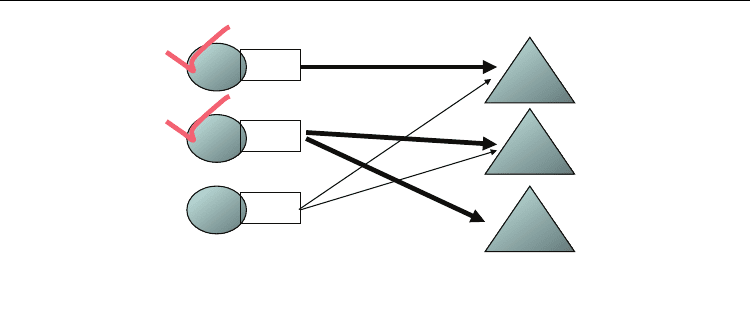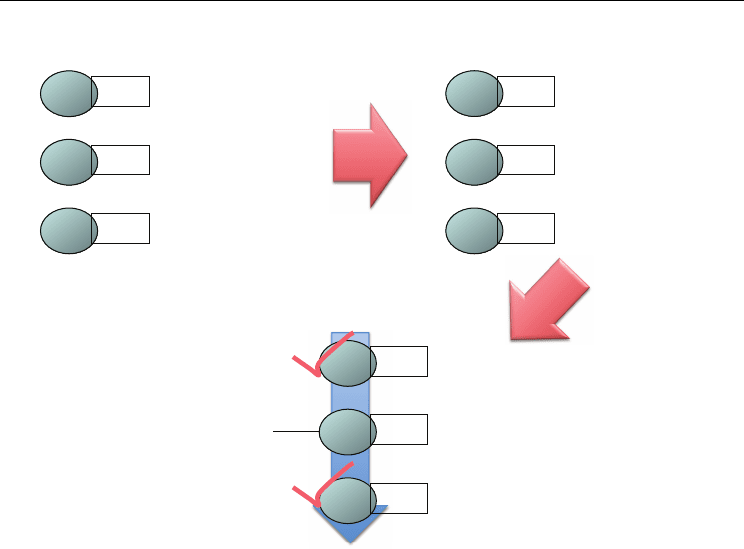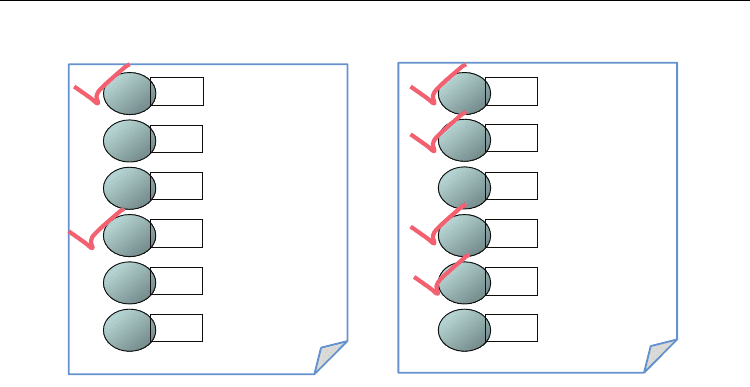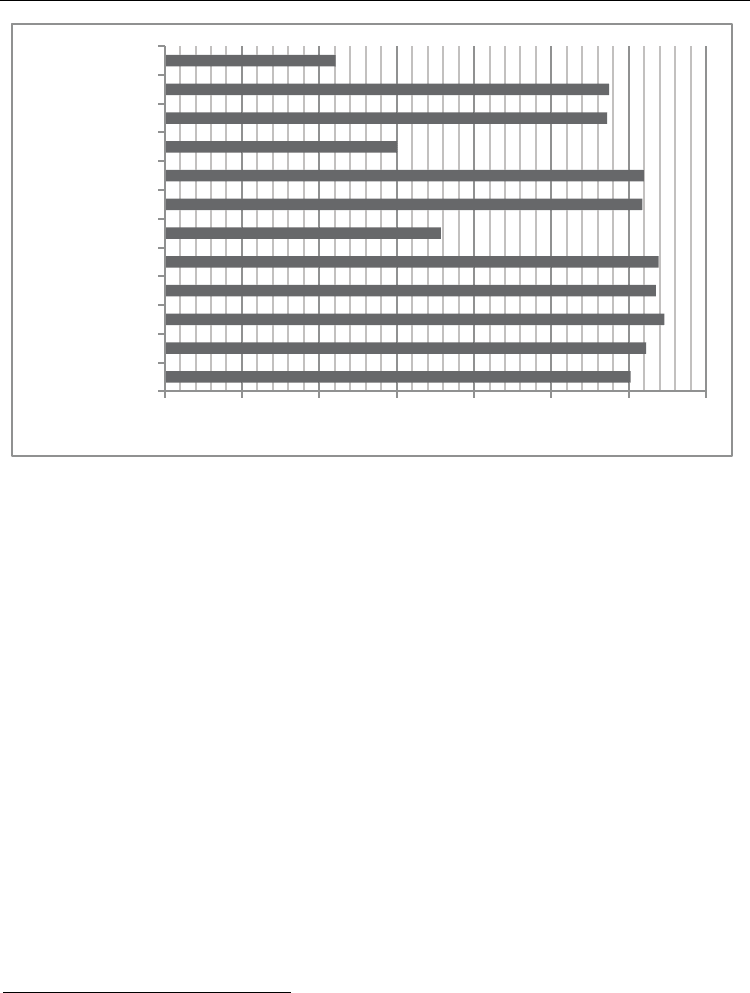Bednorz W. (ed.) Advances in Greedy Algorithms
Подождите немного. Документ загружается.

22
Parallel Greedy Approximation on Large-Scale
Combinatorial Auctions
Naoki Fukuta
1
and Takayuki Ito
2,3
1
Shizuoka University,
2
Nagoya Institute of Technology
3
Massachusetts Institute of Technology
1,2
Japan
3
United States
1. Introduction
Combinatorial auctions (Cramton et al., 2006) are auctions that allow bidders to place bids
for a set of items. Combinatorial auctions provide suitable mechanisms for efficient
allocation of resources to self-interested attendees (Cramton et al., 2006). Therefore, many
works have been done to utilize combinatorial auction mechanisms for efficient resource
allocation. For example, the FCC tried to employ combinatorial auction mechanisms for
assigning spectrums to companies (McMillan, 1994).
On the other hand, efficient resource allocation is also becoming crucial in many computer
systems that should manage resources efficiently, and combinatorial auction mechanisms
are suitable for this situation. For example, considering a ubiquitous computing scenario,
there is typically a limited amount of resources (sensors, devices, etc.) that may not cover all
needs for all users. Due to certain reasons (physical limitations, privacy, etc.), most of the
resources cannot be shared with other users. Furthermore, software agents will use two or
more resources at a time to achieve desirable services for users. Of course, each software
agent provides services to its own user, and the agent may be self-interested.
Tremendous research efforts have been done to improve many parts of combinatorial
auctions. An example is recent efforts for winner determination problem. In general, the
optimal winner determination problem of a combinatorial auction is NP-hard (Cramton et
al., 2006) for the number of bids. Thus, much work focuses on tackling the computational
costs for winner determination (Fujishima et al., 1999); (Cramton et al., 2006); (Sandholm et
al., 2005). Also many efforts have been done for generic problem solvers that can be applied
to solve winner determination problems.
However, in such ubiquitous computing scenarios, there is strong demand for completing
an auction within a fine-grained time period without loss of allocation efficiency. In a
ubiquitous computing scenario, the physical location of users may always be changing and
that could be handled by the system. Also, each user may have multiple goals with different
contexts, and those contexts are also dynamically changing. Therefore, resources should be
re-allocated in a certain fine-grained period to keep up with those changes in a timely
manner. For better usability, the time period of resource reallocation will be 0.1 to several

Advances in Greedy Algorithms
412
seconds depending on services provided there. Otherwise, resources will remain assigned to
users who no longer need them while other users are waiting for allocation.
Also, in the above scenarios, it is very important to handle a large number of bids in an
auction. Consider that if there are 256 resources and 100 agents, and each agent has 200 to
1000 bids, then there will be 20,000 to 100,000 bids for 256 items in an auction. However, it
has been difficult to complete such a large-scale combinatorial auction within a very short
time. Such hard time constraint even prevents algorithms to prepare a rich pre-processing to
reach optimal results in (not very) short time.
Since greedy algorithm is so simple, it can be applied to such situations. However, a pure
greedy algorithm typically provides lower optimality of results that are not satisfiable for
applications. When we solve this issue, parallel greedy approach can be a good solution for this
kind of problems. Furthermore, a simple greedy algorithm can be used to enforce results to
satisfy desirable properties that are very important for both theoretical and practical reasons.
In this chapter, we describe how greedy algorithms can be effectively used in mechanism
design, especially, on designing and implementing combinatorial auction mechanisms.
2. Combinatorial auctions and winner determination problem
2.1 Mechanism design and combinatorial auctions
An auction mechanism is an economic mechanism for efficient allocations of items to self-
interested buyers with agreeable prices. When the auction mechanism is truthful, i.e., it
guarantees incentive compatibility, the mechanism enforces the bidders to locate their bids
with true valuations. In such auctions, since we have an expectation of obtaining bids with
true valuations, we can allocate items to buyers efficiently even though some buyers may try
to cheat the mechanisms out of gaining sufficient incomes from them. For example, Vickrey
proposed an auction mechanism that has incentive compatibility (Vickrey, 1961). That is a
basic difference from ordinary resource allocation mechanisms that have implicit
assumptions of truth-telling attendees.
Combinatorial auction is an auction mechanism that allows bidders to locate bids for a
bundle of items rather than single item (Cramton et al., 2006). Combinatorial auction has
been applied for various resource allocation problems. For example, McMillan et al.
reported a trial on an FCC spectrum auction (McMillan, 1994). Rassenti et al. reported a
mechanism for an airport time slot allocation problem (Rassenti et al., 1982). Ball et al.
discussed applicability of combinatorial auctions to airspace system resource allocations
(Ball et al., 2006). Caplice et al. proposed a bidding language for optimization of procurement
on freight transportation services (Caplice et al., 2004). Estelle et al. proposed a formalization
on auctioning London Bus Routes (Cantillon & Pesendorfer, 2004). Hohner et al. presented an
experience on procurement auctions at a software company (Hohner et al., 2003).
However, on emerging applications with such resource allocation problems, their problem
spaces are larger, more complex, and much harder to solve compared to previously
proposed applications. For example, Orthogonal Frequency Division Multiple Access
(OFDMA) technology enables us to use a physically identical frequency bandwidth as
virtually multiplied channels at the same time, and this causes the channel allocation
problem to become more difficult (Yang & Manivannan, 2005). Also some recent wireless
technologies allow us to use multiple channels on the same, or different physical layers (i.e,
WiFi, WiMax, and Bluetooth at the same time) for attaining both peak speed and robust
connectivity (Salem et al., 2006); (Niyato and Hossain, 2008). Furthermore, such resource

Parallel Greedy Approximation on Large-Scale Combinatorial Auctions
413
allocation should be done for many ordinary users rather than a fixed limited number of
flights or companies. Also the contexts of users, which are dynamically changing through
the time, should be considered in the allocation.
In this chapter, to maintain simplicity of discussion, we focus on utility-based resource
allocation problems such as (Thomadakis & Liu, 1999), rather than generic resource
allocation problems with numerous complex constraints. The utility-based resource
allocation problem is a problem that aims to maximize the sum of utilities of users for each
allocation period, but does not consider other factors and constraints (i.e., fair allocation
(Sabrina et al., 2007); (Andrew et al., 2008), security and privacy concerns (Xie & Qin, 2007),
uncertainty (Xiao et al., 2004), etc).
Also, throughout this chapter, we only consider auctions that are single-sided, with a single
seller and multiple buyers to maintain simplicity of discussion. It can be extended to the
reverse situation with a single buyer and multiple sellers, and the two-sided case. The two-
sided case is known as the combinatorial exchange. In the combinatorial exchange
mechanisms, multiple sellers and multiple buyers are trading on a single trading
mechanism. About this mechanism, the process of determining winners is almost the same
as single-sided combinatorial auctions. However, it is reported that the revenue division
among sellers can be a problem. There are a lot of interesting studies on combinatorial
exchange (Parkes et al, 2005).
2.2 Winner determination problem
An important issue on combinatorial auction is representation of bids. In this chapter, we
use OR bid representation(Lehmann et al., 2006), a simplest one in major formalisms.
On OR bid representation, the winner determination problem on combinatorial auction
WDP
OR
is defined as follows (Cramton et al., 2006): The set of bidders is denoted by
N={1,...,n}, and the set of items by M={m
1
,...,m
k
}. |M|=k. Bundle S is a set of items:
S ⊆ M
.
We denote by v
i
(S), bidder i's valuation of the combinatorial bid for bundle S. An allocation
of the items is described by variables
x
i
(S) ∈{0, 1}
, where x
i
(S)=1 if and only if bidder i wins
bundle S. An allocation, x
i
(S), is feasible if it allocates no item more than once,
i∈N
Sj
x
i
(S) ≤ 1
for all
j ∈ M
.
The winner determination problem is the problem to maximize total revenue
max
X
i∈N,S⊆M
v
i
(S)x
i
(S)
for feasible allocations
X x
i
(S)
.
Fig. 1 shows an example of WDP
OR
. Consider there are three items a, b, and c, and three
bidders Alice, Bob, and Charles. Alice bids 10 for a. Bob bids 20 for {b, c}. Charles bids 18 for {a,
b}. The problem is to choose winners of this auction from those three bids. Here, to choose
Alice's and Charles's, or Bob's and Charles's are infeasible allocation, since both Alice's and
Charles's include item a, and both Bob's and Charles's include item b. The optimal allocation is
a for Alice, and b and c for Bob.

Advances in Greedy Algorithms
414
Fig. 1. Winner Determination Problem
Since the winner determination problem WDP
OR
is a combinatorial optimization problem, it
is generally NP-hard(Cramton et al., 2006). Furthermore, winner determination also plays
important roles in other parts of combinatorial auction mechanism. For example, some
combinatorial auction mechanisms (e.g., VCG, etc.) require many times of winner determination
for slightly different bids for pricing mechanism. Therefore, it is strongly demanded to solve the
problem in tractable way. In this chapter, we focus on solving this problem.
2.3 Lehmann’s greedy winner determination
Lehmann et al. proposed a combinatorial auction mechanism that preserves truthfulness, a
very important desirable property, while it uses a greedy approximation algorithm for its
winner determination(Lehmann et al., 2002).
Lehmann's greedy algorithm (Lehmann et al., 2002) is a very simple but powerful linear
algorithm for winner determination in combinatorial auctions. Here, we denote a bid
b=<s,a>, such that
S ⊆ M
and
a ∈R
+
. Two bids b=<s,a> and b'=<s',a'> conflict if and
only if
s ∩ s
= ∅
. The greedy algorithm can be described as follows. (1) The bids are sorted
by some criterion. In (Lehmann et al., 2002), Lehmann et al. proposed sorting list L by
descending average amount per item. More generally, they proposed sorting L by a criterion
of the form a/|s|
c
for some number
c ≥ 0
, possibly depending on the number of items, k. (2)
A greedy algorithm generates an allocation. L is the sorted list in the first phase. Walk down
the list L, allocates items to bids whose items are still unallocated.
Example: Assume there are three items a, b, and c, and three bidders Alice, Bob, and Charles.
Alice bids 10 for a. Bob bids 20 for {b,c}. Charles bids 18 for {a,b} (Fig. 2 Step1). We sort the bids
by the criterion of the form a/|s|
0.5
(Fig. 2 Step2). Alice's bid is calculated as 10/1
0.5
=10. Bob's
bid is calculated as 20/2
0.5
=14 (approximately). Charles's bid is calculated as 18/2
0.5
=13
(approximately). The sorted list is now Bob's bid <{b,c},20>, Charles's bid <{a,b},18>, and
Alice's bid <{a}, 10>. The algorithm walks down the list (Fig. 2 Step3). At first, Bob wins {b,c}
for 20. Then, Charles cannot get the item because his bid conflicts with Bob's bid. Finally,
Alice gets {a} for 10.
Lehmann's greedy algorithm provides a computationally tractable combinatorial auction.
However, it has two remaining issues: (1)efficiency of item assignment, and (2)adjustment of
good bid weighting parameter c. In the next section, we describe possible approaches for
these issues.

Parallel Greedy Approximation on Large-Scale Combinatorial Auctions
415
!
"
!&
! !
!"
'!
" "
!"
'!$!
!&"
!"
'!"%
!
!
"
!&
! !
!"
'!
" "
!"
'!$!
!&"
!"
'!"%
"
#
!
"
!&
Fig. 2. Lehmann’s Greedy Allocation
3. Parallel greedy approximation
3.1 Incremental updating
In (Fukuta & Ito, 2006), we have shown that the hill-climbing approach performs well when
an auction has a massively large number of bids. In this section, we summarize our
proposed algorithms for incremental updating solutions.
Lehmann's greedy winner determination could succeed in specifying the lower bound of the
optimality in its allocation (Lehmann et al., 2002). A straightforward extension of the greedy
algorithm is to construct a local search algorithm that continuously updates the allocation so
that the optimality is increased. Intuitively, one allocation corresponds to one state of a local
search.
List 1 shows the algorithm. The inputs are Alloc and L. L is the bid list of an auction. Alloc is
the initial greedy allocation of items for the bid list.
The function consistentBids finds consistent bids for the set NewAlloc by walking down the
list RemainBids. Here, a new inserted bid will wipe out some bids that conflict with the
inserted bid. So there will be free items to allocate after the insertion. The function
consistentBids tries to insert the other bids greedily for selling as many of the items as
possible. When the total price for NewAlloc is higher than Alloc, current allocation is
updated to NewAlloc and the function continues updating from NewAlloc. We call this as
Greedy Hill Climbing(GHC) in this chapter.

Advances in Greedy Algorithms
416
1: function GreedyHillClimbingSearch(Alloc, L)
2: RemainBids:= L - Alloc;
3: for each b ∈ RemainBids as sorted order
4: if b conflicts Alloc then
5: Conflicted:=Alloc - consistentBids({b}, Alloc);
6: NewAlloc:= Alloc - Conflicted + {b};
7: ConsBids:=
8: consistentBids(NewAlloc, RemainBids);
9: NewAlloc:=NewAlloc+ConsBids;
10: if price(Alloc) <price(N ewAlloc) then
11: return GreedyHillClimbingSearch(NewAlloc,L);
12: end for each
13: return Alloc
List. 1. Greedy Hill Climbing Algorithm
• Initial State
– AL : Current allocation of items
(The initial allocation is Lehmann’s allocation.)
– Remain : All bids that are not included in AL
A&B&C
30
D&E
15
A
15
C
13
A&C
14
B
8
Total revenue = 45
AL
Remain
– Take the top of bid in Remain,
then push it into AL
A&B&C
30
D&E
15
A
15
C
13
A&C
14
B
8
PUSH IN
PUSH
OUT
AL
Remain
– (In this case,
item B and C are not allocated.)
Lehmann’s algorithm is applied to the non-
allocated items.
A&B&C
30
D&E
15
A
15
C
13
A&C
14
B
8
Apply Lehmann’s
algorithm for not
currently allocated
items.
AL
Remain
– If the total revenue is larger than the last
then the found allocation overwrites AL.
A&B&C
30
D&E
15
A
15
C
13
A&C
14
B
8
Put back to Remain
Total revenue = 51 ( larger than the last revenue = 45)
AL
Remain
A
A
A
A
A
A
Fig. 3. Example of Greedy Hill Climbing
Example: Assume there are five items a, b, c, d, and e, and there are six bids, <{a,b,c},30>,
<{a},15>, <{c},13>, <{d,e},15>, <{a,c},14>, and <{b},8>. We can calculate the values of
Lehmann's criterion a/|s|
0.5
as 17.6, 15, 13, 10.7, 10, and 8, respectively. In this case, the
initial allocation is Lehmann's greedy allocation <{a,b,c},30>, <{d,e},15> and the total revenue
is 45. Here, the remaining list contains <{a},15>, <{c},13>, <{a,c},14>, and <{b},8> (Fig. 3,

Parallel Greedy Approximation on Large-Scale Combinatorial Auctions
417
Step1). In this algorithm, we pick <{a},15> since it is the top of the remaining list. Then we
insert <{a},15> into the allocation and remove <{a,b,c},30>. The allocation is now <{a},15>,
<{d,e},15> (Fig. 3, Step2). We then try to insert the other bids that do not conflict with the
allocation (Fig. 3, Step3). Then, the allocation becomes <{a},15>, <{b},8>, <{c},13>,<{d,e},15>.
The total revenue is 51, and is increased. Thus, the allocation is updated to it (Fig. 3, Step4).
Our local algorithm continues to update the allocation until there is no allocation that has
greater revenue. This could improve the revenue that Lehmann's greedy allocation can
achieve.
To show the advantages of greedy incremental updating, we also prepared an ordinary Hill-
Climbing local search algorithm. List.2. shows the algorithm. The difference to above is to
choose best alternatives in each climbing step, instead of choosing it greedily. We call this as
Best Hill Climbing(BHC) in this chapter.
1: function BestHillClimbingSearch(Alloc, L)
2: MaxAlloc := φ
3: RemainBids:= L - Alloc;
4: for each b ∈ RemainBids as sorted order
5: if b conflicts Alloc then
6: Conflicted:=Alloc - consistentBids({b}, Alloc);
7: NewAlloc:= Alloc - Conflicted + {b};
8: ConsBids:=
9: consistentBids(NewAlloc, RemainBids);
10: NewAlloc:=NewAlloc+ConsBids;
11: if price(MaxAlloc) <price(NewAlloc) then
12: MaxAlloc := NewAlloc;
13: end for each
14: if price(Alloc) <price(MaxAlloc) then
15: return BestHillClimbingSearch(MaxAlloc,L
);
16: return Alloc
List. 2. Best Hill Climbing Algorithm
3.2 Parallel search for multiple weighting strategies
The optimality of allocations got by Lehmann's algorithm (and the following hill-climbing)
deeply depends on which value was set to c in the bid weighting function. Again, in
(Lehmann et al., 2002), Lehmann et al. argued that c=1/2 is the best parameter for
approximation when the norm of the worst case performance is considered. However,
optimal value for approximating an auction is varied from 0 to 1 depending on the auction
problem.
For example, when we choose c=1 in the example in section 3.1, we can get better results
directly at the time of initial Lehmann's greedy allocation (Fig. 4).
In (Fukuta & Ito, 2006), we presented an initial idea of an enhancement for our incremental
updating algorithm to parallel search for different bid weighting strategies (e.g, doing the
same algorithm for both c=0 and c=1).

Advances in Greedy Algorithms
418
Fig. 4. Effects of Bid Weighting Strategy
3.3 Simulated annealing search
We also prepared a small extension of the shown algorithm to the simulated annealing local
search(Fukuta & Ito, 2006). The algorithm is a combination of the presented hill-climbing
approach and a random search based on the standard simulated annealing algorithm. We
use a parameter that represents the temperature. The temperature is set at a high value at
the beginning and continuously decreased until it reaches 0. For each cycle, a neighbour is
randomly selected and its value may be less than the current value in some cases. Even in
such a case, if a probability value based on the temperature is larger than 0, the state is
moved to the new allocation that has less value. This could make us get off the local
minimum.
We prepared this algorithm only for investigating how random search capability will
improve the performance. Note that the proposed SA search may not satisfy our proposed
features discussed later.
4. Experimental analysis
4.1 Experiment settings
In this section, we compare our algorithms to other approaches in various datasets. Details
about other approaches are presented in section 5.
We implemented our algorithms in a C program for the following experiments. We also
implemented the Casanova algorithm(Hoos & Boutilier, 2000) in a C program. However, for
the following experiments, for Zurel's algorithm we used Zurel's C++ based implementation
that is shown in (Zurel & Nisan, 2001). Also we used CPLEX Interactive Optimizer 11.0.0
(32bit) in our experiments.
The experiments were done with the above implementations to examine the performance
differences among algorithms. The programs were employed on a Mac with Mac OS X 10.4,
CoreDuo 2.0GHz CPU, and 2GBytes of memory. Thus, actual computation time will be
much smaller when we employ parallel processor systems in a distributed execution
environment.

Parallel Greedy Approximation on Large-Scale Combinatorial Auctions
419
We conducted several experiments. In each experiment, we compared the following search
algorithms. greedy(c=0.5) uses Lehmann's greedy allocation algorithm with parameter
(c=0.5). greedy-N uses the best results of Lehmann's greedy allocation algorithm for N
different weighting parameters (
0 ≤ c ≤ 1
). *HC(c=0.5) uses a local search in which the
initial allocation is Lehmann's allocation with c=0.5 and conducts one of hill-climbing
searchs (e.g., GHC or BHC) shown in the previous section. Similarly, *HC-N uses the best
results of a hill-climbing search (e.g., GHC or BHC) for N different weighting parameters
(
0 ≤ c ≤ 1
). For example, GHC-11 means the best result of greedy hill-climbing(GHC) with
parameter c = {0, 0.1,...,0.9, 1}. SA uses the simulated annealing algorithm presented in
(Fukuta & Ito, 2006). Also, we denote the Casanova algorithm as casanova and Zurel's
algorithm as Zurel.
In the following experiments, we used 0.2 for the epsilon value of Zurel's algorithm in our
experiments. This value appears in (Zurel & Nisan, 2001). Also, we used 0.5 for np and 0.15
for wp on Casanova, which appear in (Hoos & Boutilier, 2000). Note that we set maxTrial to 1
but maxSteps to ten times the number of bids in the auction.
4.2 Evaluation on basic auction dataset
In (Zurel & Nisan, 2001), Zurel et al. evaluated the performance of their presented algorithm
with the data set presented in (de Vries & Vohra, 2003), compared with CPLEX and other
existing implementations.
In (Fukuta & Ito, 2007a), we presented comparison of our algorithms, Casanova, and Zurel's
algorithm with the dataset provided in (de Vries & Vohra, 2003). This dataset contains 2240
auctions with optimal values, ranging from 25 to 40 items and from 50 to 2000 bids. Since
the data set is small, we omit details in this chapter.
We conducted detailed comparisons with common datasets from CATS benchmark(Leyton-
Brown et al., 2000). Compared to deVries' dataset shown in (de Vries & Vohra, 2003), the
CATS benchmark is very common and it contains more complex and larger datasets.
Fig. 5 shows the comparison of our algorithms, Casanova, and Zurel's algorithm with a
dataset provided in the CATS benchmark (Leyton-Brown et al., 2000). The dataset has
numerous auctions with optimal values in several distributions. Here we used varsize
which contains a total of 7452 auctions with reliable optimal values in 9 different
distributions
1
. Numbers of items range from 40 to 400 and numbers of bids range from 50 to
2000.
Since problems in the dataset have relatively small size of bids and items, we omitted the
execution time since all algorithms run in very short time. Here, we can see that the
performances of GHC-11 and SA are better than Zurel's on average optimality.
Note that those differences come from the differences of the termination condition on each
algorithm. In particular, Casanova spent much more time compared with the other two
algorithms. However, we do not show the time performance here since the total execution
time is relatively too small to be compared.
1
Since some of the original data seems corrupted or failed to obtain optimal values, we
excluded such auction problems from our dataset. Also, we excluded a whole dataset of a
specific bid distribution when the number of valid optimal values is smaller than the other
half of the data. The original dataset provides optimal values of auction problems by two
independent methods, CASS and CPLEX. Therefore, it is easy to find out such corrupted
data from the dataset.

Advances in Greedy Algorithms
420
%
%# %
%#
%
%$%
%$!
%
%$##
%$#
%$%
%$ !
%$!
$" $$ % % % %" %$
&!
&!
&!
Fig. 5. Optimality on CATS-VARSIZE dataset
Here, we can see the performance of both greedy, GHC, and BHC increases when we use
more threads to parallel search for multiple weightings. For example, the result of GHC-3 is
better than GHC(c=0.5) and GHC-11 is slightly better in the average. It shows that our
parallel approximation approach will increase the performance effectively even when the
number of parallel executions is small.
Also we compared the performance on our greedy local updating approach (GHC) with
ordinary best updating approach (BHC). Surprisingly, the average performances of GHC are
slightly better than BHC, regardless of using parallel search. This is because the BHC
approach is still heuristic one so it does not guarantee the choice is best for global
optimization. Also we think we found a very good heuristic bid weighting function for our
greedy updating.
4.3 Evaluation on large auction dataset
The CATS common datasets we used in Section 4.2 have a relatively smaller number of bids
than we expected. We conducted additional experiments with much greater numbers of
bids. We prepared additional datasets having 20,000 non-dominated bids in an auction. The
datasets were produced by CATS (Leyton-Brown et al., 2000) with default parameters in 5
different distributions. In the datasets, we prepared 100 trials for each distribution. Each trial
is an auction problem with 256 items and 20,000 bids
2
.
2
Due to the difficulty of preparing the dataset, we only prepared 5 distributions. For more
details about the bid generation problem, see (Leyton-Brown et al., 2000). A preliminary
result of this experiment was shown in (Fukuta & Ito, 2007b).
